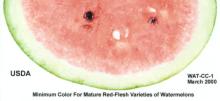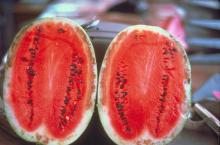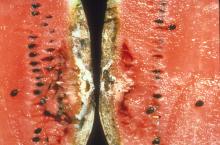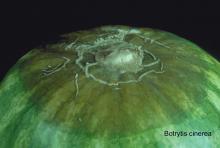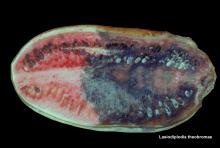Product Description
Índices de madurez
Watermelon (Citrullus lanatus Thunb.) are harvested at full maturity as they typically do not develop in internal color or increase in sugars after being removed from the vine. The ground spot (the portion of the melon resting on the soil) changes from pale white to a creamy yellow at proper harvest maturity. Another indicator used at harvest include a wilted but not fully desiccated vine tendril proximal to the stem-end attachment. Destructive sampling is used to judge maturity of a population of watermelons. For seeded cultivars, maturity is reached when the gelatinous covering (aril) around the seed is no longer apparent and the seed coat is hard. Cultivars vary widely in soluble solids at maturity. In general, a soluble solids content of at least 10% in the flesh near the center of the melon is an indicator of proper maturity if the flesh is also firm, crisp and of good color.
- Watermelons should be symmetrical and uniform in appearance
- The surface should be waxy and bright in appearance
- Absence of scars, sunburn, transit abrasions or other surface defects or dirt
- No evidence of bruising
- Appears heavy for size
U.S. grades Fancy, No. 1, and No. 2. Distinction among grades is based predominantly on external appearances.
Manejo y almacenamiento poscosecha
10-15°C (50-59°F) Storage life is typically 14 days at 15°C (59°F) with up to 21 days attainable at 7-10°C (45-50°F).
For short-term storage or transit to distant markets (>7 days), most recommendations use 7.2°C (45°F) and 85-90% R.H. as the acceptable handling conditions. Watermelons are, however, prone to chilling injury at this temperature. Extended holding at this temperature will induce chilling injury, rapidly evident after transfer to typical retail display temperatures.
Many watermelons are still shipped without precooling or refrigeration during transit. These fruit must be utilized for prompt market sales as quality declines rapidly under these conditions.
| Temperature °C °F | ml CO2/kg·hr | |
| 0 | 32 | NR |
| 5 | 41 | 3-4 |
| 10 | 50 | 6-9 |
| 15 | 59 | NA |
| 20 | 68 | 17-25 |
| 25 | 77 | NA |
To calculate heat production multiply ml CO2/kg·hr by 440 to get Btu/ton/ day or by 122 to get kcal/metric ton/day.
NR - not recommended due to chilling injury.
NA - not available.
Exposure to an ethylene concentrations as low as 5ppm for 7 days at 18°C (64°F) will cause unacceptable loss of firmness and eating quality.
85-90%; High relative humidity is generally advisable to reduce desiccation and loss of glossiness.
Low: 0.1-1.0 µl/kg·hr at 20°C (68°F)
Controlled atmosphere storage or shipping are not recognized as offering controlled benefits for watermelon.
Cut watermelon for slices or cubes for fresh-cut fruit salads have a very short period of optimal quality. Flesh becomes water-soaked and mealy. Varietal performance for fresh-cut is not currently available.
Desórdenes
Chilling injury. Typically occurs after storage at temperatures < 7°C (45°F) Disorders for several days. Symptoms of chilling injury include pitting, decline in flesh color, loss of flavor, off-flavors and increased decay when returned to room temperatures.
Improper handling and loading of bulk watermelons too often result in serious transit losses due to bruising and cracking. Internal bruising leads to premature flesh breakdown and mealiness.
Disease can be an important source of postharvest loss depending on season, Disorders region and local climatic conditions at harvest. Generally these losses are low in comparison with physical injury due to bruising and rough handling. Black Rot, caused by Didymella bryoniae, Anthracnose caused by Colletotrichum orbiculare, and Phytophthora Fruit Rot are common in areas with high rainfall and humidity during production and harvest An extensive list of stem-end, blossom-end, rind decay or surface lesions may occur, including the bacterium Erwinia and the fungal pathogens Alternaria, Botrytis, Cladosporium, Geotrichum, Rhizopus, and occasionally Mucor, Fusarium, and Tricothecium.
References
References from scientifically validated sources will be added in the future.



